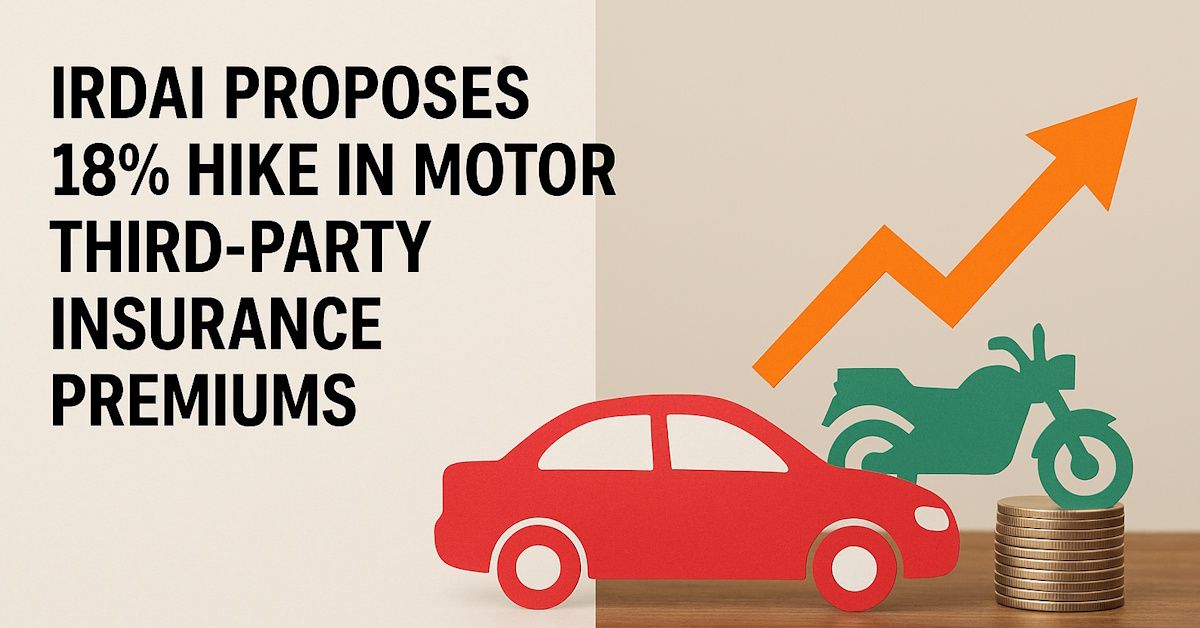Car And Two Wheeler Insurance Premiums To Get More Expensive: Explained!


The quiet hum of anticipation among vehicle owners has grown louder this week as news broke that insurance premiums are likely to rise soon. The Insurance Regulatory and Development Authority of India (IRDAI) has recommended an average increase of 18 percent in Motor Third-Party (TP) insurance premiums, with some categories facing even steeper hikes of up to 25 percent. This proposal is now under active review by the Ministry of Road Transport and Highways, with a final decision expected in the coming weeks. For many, this signals the end of a four-year freeze on premium rates, a period during which claim costs and loss ratios have steadily climbed.
This development is particularly significant because Motor Third-Party insurance is mandatory for all vehicle owners. It covers liability for injuries or damages to third parties in road accidents, a critical safety net on India’s bustling roads. In the last financial year, TP insurance accounted for 60 percent of all motor insurance premiums, making it a cornerstone of the general insurance sector. The proposed hike, if approved, will impact everyone from two-wheeler riders to commercial vehicle operators, as well as those eyeing new car launches and updates.
The backdrop to this move is a challenging one for insurers. Over the past four years, while premiums remained static, the costs of medical treatment, legal settlements, and vehicle repairs have surged. Insurers’ loss ratios, a measure of claims paid out relative to premiums collected, have reached worrying levels. In both FY23 and FY24, the net claims ratio for the TP segment stood at around 82 percent, while the ultimate loss ratio climbed from 88.3 percent to 91.3 percent. In simple terms, insurers are now spending nearly as much, or more, on claims than they collect in premiums.
This squeeze has put immense pressure on the financial health of general insurers, making a premium hike not just likely, but necessary. Industry analysts suggest that the proposed increase could improve insurers’ combined ratios by 400–500 basis points, providing much-needed relief to balance sheets that have been under strain for years.
For the average vehicle owner, the impending hike translates to a higher annual outlay for mandatory insurance. For instance, if the proposal is approved, the cost of third-party cover for various vehicle categories could jump by 18–25 percent. While the exact figures will depend on the final notification, the direction is clear: owning and maintaining a vehicle is about to get more expensive.
There’s a silver lining, though. The hike is aimed at ensuring the long-term viability of the insurance sector, which in turn guarantees timely and adequate compensation for accident victims. In a country where road accidents remain a grim reality, a robust insurance system is essential for social security.
For automotive enthusiasts and casual readers alike, this development is more than just a story about rising costs. It’s a window into the complex balancing act between regulatory oversight, industry sustainability, and consumer protection. While we have long debated the fairness of premium hikes, especially when they coincide with periods of economic uncertainty or rising fuel prices. Many argue that while higher premiums are unwelcome, they are preferable to an underfunded insurance sector that cannot honour claims.
There’s also the question of how premiums are calculated. While the current proposal focuses on across-the-board hikes, there’s growing interest in risk-based pricing, where safer drivers and those with fewer claims could pay less. This approach, already discussed in enthusiast circles, could be the next frontier in motor insurance reform.
Once the Ministry of Road Transport and Highways gives its nod, a draft notification will be released for public consultation. This will offer stakeholders, including vehicle owners and industry bodies, a chance to voice their opinions before the revised premiums are implemented which is likely in the upcoming quarter.
For now, the message is clear: insurance premiums are set to rise, ending a period of relative stability. While this may pinch the pocket in the short term, it’s a move aimed at safeguarding the interests of both insurers and the insured in the long run. For anyone passionate about vehicles, it’s a reminder that the world of motoring is as much about financial prudence as it is about horsepower and design flair.
Via CNBC